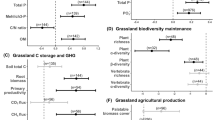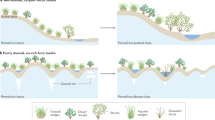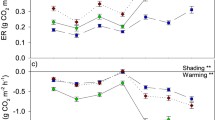Abstract
Environmental regulations governing industrial activities in tundra environments stem largely from the expected ecological effects of the activities. One of the major ecological effects of industrial activities is the surface subsidence associated with thermokarst, which can result in changes in primary and secondary production. The primary production changes associated with thermokarst are strongly governed by three ecosystem properties—soil temperature, water regime, and nutrient availability. Most disturbances set in motion a more-or-less predictable sequence of landscape change related to these properties: soil warming, thermokarst, surface flooding, accelerated organic matter decomposition, and increased nutrient availability. The warmed soil and the enhanced nutrient availability typically lead to increased annual primary production, increased dominance by graminoids, and reduced plant species diversity. These vegetational changes may in turn potentially enhance secondary production, but in general these second-level responses have yet to be quantified. More information is needed about the food-chain effects of tundra landscape disturbances before regulators can make well-informed predictions of impacts or plan useful habitat rehabilitation.
Similar content being viewed by others
Literature Cited
Adam, K. M., and H. Hernandez. 1977. Snow and ice roads: Ability to support traffic and effects on vegetation.Arctic 30:13–27.
Alexander, V., and M. C. Miller. 1977. Effects of road construction on nearby lakes on Alaska's north slope. Report RLO-2229-T9-2. University of Alaska, Institute of Marine Sciences, Fairbanks, 51 pp.
Alexander, V., and K. Van Cleve. 1983. The Alaska pipeline: A success story.Annual Review of Ecology and Systematics 14:443–463.
Alexander, V., D. W. Stanley, R. J. Daley, and C. P. McRoy. 1980. Primary producers. Pages 179–250in J. E. Hobbie (ed.), Limnology of tundra ponds: Barrow, Alaska. Dowden, Hutchinson, and Ross, Stroudsburg, Pennsylvania.
Archer, S., and L. L. Tieszen. 1980. Growth and physiological responses of tundra plants to defoliation.Arctic and Alpine Research 12:531–552.
Batzli, G. O., and H. G. Jung. 1980. Nutritional ecology of microtine rodents: Resource utilization near Atkasook, Alaska.Arctic and Alpine Research 12:483–499.
Batzli, G. O., R. G. White, and F. L. Bunnell. 1981. Herbivory: A strategy of tundra consumers. Pages 359–375in L. C. Bliss, J. B. Cragg, D. W. Heal, and J. J. Moore (eds.), Tundra ecosystems: A comparative analysis. International Biology Program 25. Cambridge University Press, Cambridge, UK.
Bergman, R. D., and D. V. Derksen. 1977. Observations on Arctic and red-throated loons at Storkersen Point, Alaska.Arctic 30:41–51.
Bilgin, A. 1975. Nutrient status of surface waters as related to soils and other environmental factors in a tundra ecosystem. Doctoral dissertation, Rutgers University, New Brunswick, New Jersey.
Billings, W. D. 1987. Constraints to plant growth, reproduction, and establishment in arctic environments.Arctic and Alpine Research 19:357–365.
Bliss, L. C. 1986. Arctic ecosystems: Their structure, function and herbivore carrying capacity. Pages 5–25in O. Gudmundsson (ed.), Grazing research at northern latitudes, Plenum Publishing, New York.
Britton, M. E. 1957. Vegetation of the arctic tundra. Pages 67–130in H. P. Hansen (ed.), Arctic biology: 18th biology colloquium. Oregon State University Press, Corvallis.
Brown, J., and N. A. Grave. 1979. Physical and thermal disturbance and protection of permafrost. CRREL Report SR79-5. US Army Cold Regions Research and Engineering Laboratory, Hanover, New Hampshire, 43 pp.
Brown, J., B. E. Brockett, and K. E. Howe. 1984. Interaction of gravel fills, surface drainage, and culverts with permafrost terrain. CRREL Report 84-11. US Army Cold Regions Research and Engineering Laboratory, Hanover, New Hampshire, 35 pp.
Bunnell, F. L., S. F. MacLean Jr., and J. Brown. 1975. Barrow, Alaska, U.S.A. Pages 73–124in T. Rosswall and O. W. Heal (eds.), Structure and function of tundra ecosystems. Ecological Bulletin 20. Stockholm, Sweden.
Cargill, S. M., and F. S. Chapin, III. 1987. Application of successional theory to tundra restoration: A review.Arctic and Alpine Research 19:366–372.
Challinor, J. L., and P. L. Gersper. 1975. Vehicle perturbation effects upon a tundra soil plant system. II. Effects on the chemical regime.Soil Science Society of America Proceedings 39:689–694.
Chapin, F. S., III. 1978. Phosphate uptake and nutrient utilization by Barrow tundra vegetation. Pages 484–507in L. L. Tieszen (ed.), Vegetation and production ecology of an Alaskan arctic tundra. Springer-Verlag, New York.
Chapin, F. S., III. 1979. Nutrient uptake and utilization by tundra plants. Pages 215–234in L. S. Underwood, L. L. Tieszen, A. B. Callahan, and G. E. Folk (eds.), Comparative mechanisms of cold adaptations. Academic Press, New York.
Chapin, F. S., III. 1983. Direct and indirect effects of temperature on arctic plants.Polar Biology 2:47–52.
Chapin, F. S., III., and G. Shaver. 1981. Changes in soil properties and vegetation following disturbance of Alaskan arctic tundra.Journal of Applied Ecology 18:605–617.
Chapin, F. S., III, and G. R. Shaver. 1985. Arctic. Pages 16–33in B. F. Chabot and H. A. Mooney (eds.), Physiological ecology of North American plant communities. Chapman and Hall, New York.
Chapin, F. S., III, K. Van Cleve, and L. L. Tieszen. 1975. Seasonal nutrient dynamics of tundra vegetation at Barrow, Alaska.Arctic and Alpine Research 7:209–226.
Dau, J. R., and R. D. Cameron. 1986. Effects of a road system on caribou distribution during calving. Pages 95–101in Proceedings of the fourth international reindeer/caribou symposium, 22–25 August 1985. Whitehorse, Yukon.
Dennis, J. G., L. L. Tieszen, and M. A. Vetter. 1978. Seasonal dynamics of above and below ground production of vascular plants at Barrow, Alaska. Pages 113–140in L. L. Tieszen (ed.), Vegetation and production ecology of an Alaskan arctic tundra. Springer-Verlag, New York.
Douglas, L. A., and A. Bilgin. 1975. Nutrient regimes of soils, landscapes, lakes, and streams, Prudhoe Bay, Alaska. Pages 61–70in J. Brown (ed.), Ecological investigations of the tundra biome in the Prudhoe Bay region, Alaska. Special report 2. Biological Papers of the University of Alaska, Fairbanks, Alaska.
Dowding, P., F.S. Chapin, III, F. E. Wielgolaski, and P. Kilfeather. 1981. Nutrients in tundra ecosystems. Pages 647–683in L. C. Bliss, O. W. Heal, and J. J. Moore (eds.), Tundra ecosystems: A comparative analysis. Cambridge University Press, Cambridge, UK.
Dunbar, M. J. 1973. Stability and fragility of arctic ecosystems.Arctic 26:179–185.
Eberhardt, L. E., W. C. Hanson, J. L. Bengtson, R. A. Garrott, and E. E. Hanson. 1982. Arctic fox home range characteristics in an oil-development area.Journal of Wildlife Management 46:183–190.
Ebersole, J. J., and P. J. Webber. 1983. Biological decomposition and plant succession following disturbance on the arctic coastal plain, Alaska. Pages 266–271in Permafrost: 4th international conference proceedings, University of Alaska, Fairbanks, 17–22 July 1983. National Academy Press, Washington, DC.
Everett, K. R. 1980a. Edaphic factors and their influence in patterns of tundra revegetation. Pages 30–38in C. L. Jackson and M. A. Schuster (eds.), Proceedings of the high altitude revegetation workshop, No. 4, 26–27 February 1980. Colorado State University, Fort Collins.
Everett, K. R. 1980b. Landforms. Pages 14–19in D. A. Walker, K. R. Everett, P. J. Webber, and J. Brown (eds.), Geobotanical atlas of the Prudhoe Bay Region, Alaska. CRREL Report 80-14. US Army Cold Regions Research and Engineering Laboratory, Hanover, New Hampshire.
Everett, K. R., B. M. Murray, D. F. Murray, A. W. Johnson, A. E. Linkeur, and P. J. Webber. 1985. Reconnaissance observations of long-term natural vegetation recovery in the Cape Thompson region Alaska, and additions to the checklist of flora. CRREL Report 85-11. US Army Cold Regions Research and Engineering Laboratory, Hanover, New Hampshire.
Felix, N. A., M. T. Jorgenson, M. K. Reynolds, R. Lipkin, D. L. Blank, and B. K. Lance. 1987. Effects of winter seismic exploration on visual resources, vegetation, and surface stability of the coastal plain of the Arctic National Wildlife Refuge, Alaska, 1985. ANWR Progress Report FY-86-2-Impacts. US Department of Interior, Fish and Wildlife Service, Fairbanks.
Gersper, P. L., V. Alexander, S. A. Barkley, R. J. Barsdate, and P. S. Flint. 1980. The soils and their nutrients. Pages 219–254in J. Brown, P. C. Miller, L. L. Tieszen, and F. L. Bunnell (eds.), An arctic ecosystem: The coastal tundra at Barrow, Alaska. Dowden, Hutchinson and Ross, Stroudsburg, Pennsylvania.
Gunn, A. 1982. Muskox. Pages 1021–1035in J. A. Chapman and G. A. Feldhamer (eds.), Wild mammals of North America: Biology, management, economics. The Johns Hopkins University Press, Baltimore, Maryland.
Haag, R. W. 1974. Nutrient limitations to plant production in two tundra communities.Canadian Journal of Botany 52:103–116.
Hastings, S. J., S. A. Luchessa, W. C. Oechel, and J. D. Tenhunen. 1989. Standing biomass and production in water drainages of the foothills of the Philip Smith Mountains, Alaska.Holarctic Ecology 12:304–311.
Heal, O. W., and D. D. French. 1974. Decomposition of organic matter in tundra. Pages 279–310in A. V. Holding, D. W. Heal, S. F. MacLean, Jr., and P. W. Flanagan (eds.), Soil organisms and decomposition in tundra. Tundra Biome Steering Committee, Stockholm.
Hernandez, H. 1973. Natural plant recolonization of surficial disturbances, Tuktoyaktuk Peninsula Region, N.W.T.Canadian Journal of Botany 51:2177–2196.
Hobbie, J. E. 1984. The ecology of tundra ponds of the arctic coastal plain: Community profile. US Department of Interior, Fish and Wildlife Service, Washington, DC. Report FWS/OBS-83/25. 52 pp.
Johnson, A. W., B. M. Murray, and D. F. Murray. 1978. Floristics of the disturbances and neighboring locales. Pages 30–40in D. E. Lawson, J. Brown, K. R. Everett, A. W. Johnson, V. Komarkova, B. M. Murray, D. F. Murray, and P. J. Webber (eds.), Tundra disturbances and recovery following the 1949 exploratory drilling, Fish Creek, northern Alaska. CRREL Report 78-28. US Army Cold Regions Research and Engineering Laboratory, Hanover, New Hampshire.
Johnson, L. A. 1987. Management of northern gravel sites for successful reclamation: A review.Arctic and Alpine Research 19:530–536.
Johnson, P. L., and L. L. Tieszen. 1973. Vegetative research in arctic Alaska. Pages 169–198in M. E. Britton (ed.), Alaskan arctic tundra. Technical Paper 25. Arctic Institute of North America, The University of Calgary, Alberta.
Jorgenson, M. T., M. T. Robus, C. O. Zachel, and B. E. Lawhead. 1987. Effects of a brine spill on tundra revegetation and soil in the Kuparuk Oilfield, Alaska. Alaska Biological Research, Inc., Fairbanks.
Kalff, J. 1971. Nutrient-limiting factors in an arctic tundra pond.Ecology 52:655–659.
Klinger, L. F., D. A. Walker, M. D. Walker, and P. J. Webber. 1983. The effects of a gravel road on adjacent tundra vegetation. Pages 1–162,in Prudhoe Bay Waterflood Project, environmental monitoring program, 1982. US Army Corps of Engineers, Anchorage.
Komarkova, V., and P. J. Webber. 1978. Geobotanical mapping, vegetation disturbance and recovery. pages 41–51in D. E. Lawson, J. Brown, K. R. Everett, A. W. Johnson, V. Komarkova, B. M. Murray, D. F. Murray, and P. J. Webber (eds.), Tundra disturbances and recovery following the 1949 exploratory drilling, Fish Creek, northern Alaska. CR-REL Report 78-28. US Army Cold Regions Research and Engineering Laboratory, Hanover, New Hampshire.
Komarkova, V., and P. J. Webber. 1980. Two low arctic vegetation maps near Atkasook, Alaska.Arctic and Alpine Research 12:447–472.
Kummerow, J., and B. A. Ellis. 1984. Temperature effect on biomass production and root/shoot biomass ratios in two arctic sedges under controlled environmental conditions.Canadian Journal of Botany 62:2150–2153.
Lawson, D. E. 1986. Response of permafrost terrain to disturbance: A synthesis of observations from northern Alaska, U.S.A.Arctic and Alpine Research 18:1–17.
Leader-Williams, N., T. A. Scott, and R. M. Pratt. 1981. Forage selection by introduced reindeer on South Georgia, and its consequences for the flora.Journal of Applied Ecology 18:83–106.
Mackay, J. R. 1970. Disturbances to the tundra and forest tundra environment.Canadian Geotechnical Journal 7:420–432.
Marion, G. M., S. J. Hastings, S. F. Oberbauer, and W. C. Oechel. 1989. Soil-plant relationships in a tundra ecosystem.Holarctic Ecology 12:296–303.
Mautz, W. W. 1978. Nutrition and carrying capacity. Pages 321–348in J. L. Schmidt and D. L. Gilbert (eds.), Big game of North America: Ecology and management. Stackpole Books, Stroudsburg, Pennsylvania.
McCown, B. H. 1978. The interactions of organic nutrients, soil nitrogen, soil temperature, and plant growth and survival in the arctic environment. Pages 425–456in L. L. Tieszen (ed.), Vegetation and production ecology of an Alaskan arctic tundra. Springer-Verlag, New York.
McKendrick, J. D. 1981. Responses of arctic tundra to intensive muskox grazing.Agroborealis 13:49–55.
McKendrick, J. D. 1987. Plant succession on disturbed sites, North Slope, Alaska.Arctic and Alpine Research 19:554–565.
McKendrick, J. D., and W. M. Mitchell. 1978. Fertilizing and seeding oil damaged arctic tundra to effect vegetation recovery. Prudhoe Bay, Alaska.Arctic 31:296–304.
McKendrick, J. D., V. J. Ott, and G. A. Mitchell. 1978. Effects of nitrogen and phosphorus fertilization on carbohydrate and nutrient levels inDupontia fisheri andArctagrostis latifolia. Pages 509–537in L. L. Tieszen (ed.), Vegetation and production ecology of an Alaskan arctic tundra. Springer-Verlag, New York.
McKendrick, J. D., G. O. Batzli, K. R. Everett and J. C. Swanson. 1980. Some effects of mammalian herbivores and fertilization on tundra soils and vegetation.Arctic and Alpine Research 12:565–578.
McNaughton, S. J., M. Oesterman, D. A. Frank, and K. J. Williams. 1989. Ecosystem-level patterns of primary productivity and herbivory in terrestrial habitats.Nature 341:142–144.
Oberbauer, S. F., S. J. Hastings, J. L. Beyers, and W. C. Oechel. 1989. Comparative effects of downslope water and nutrient movement on plant nutrition, photosynthesis, and growth in Alaskan tundra.Holarctic Ecology 12:324–334.
Oechel, W. C. 1989. Nutrient and water flux in a small arctic watershed: An overview.Holarctic Ecology 12:229–237.
Peterson, K. M., and W. D. Billings. 1980. Tundra vegetational patterns and succession in relation to microtopography near Atkasook, Alaska.Arctic and Alpine Research 12:473–482.
Roby, D. D. 1978. Behavioral patterns of barren-ground caribou of the central arctic head adjacent to the trans-Alaska pipeline. MS thesis. University of Alaska, Fairbanks.
Schultz, A. M. 1964. The nutrient-recovery hypothesis for arctic microtine rodents. II. Ecosystem variables in relation to arctic microtine cycles. Pages 57–68in D. J. Crisp (ed.), Grazing in terrestrial and marine environments. Blackwell Scientific Publications, Oxford, UK.
Schultz, A. M. 1969. A study of an ecosystem: The arctic tundra. Pages 77–93in G. M. van Dyne (ed.), The ecosystem concept in natural resource management. Academic Press, New York.
Sedinger, J. S., and D. G. Raveling. 1984. Dietary selectivity in relation to availability and quality of food for goslings of cackling geese.Auk 101:295–306.
Shaver, G. R., F. S. Chapin, III, and W. D. Billings. 1979. Ecotypic differentiation inCarex aquatilis on ice-wedge polygons in the Alaskan coastal tundra.Ecology 67:1025–1046.
Ulrich, A., and P. L. Gersper. 1978. Plant nutrient limitations of tundra plant growth. Pages 457–481in L. L. Tieszen (ed.), Vegetation and production ecology of an Alaskan arctic tundra. Springer-Verlag, New York.
Van Cleve, K. 1977. Recovery of disturbed tundra and taiga surfaces in Alaska. Pages 422–455in J. Cairns, K. L. Dickson, and E. E. Herricks (eds.), Proceedings of the International Symposium on Recovery of Damaged Ecosystems. University Press of Virginia, Charlottesville.
Vitousek, P. M., and L. R. Walker. 1987. Colonization, succession, and resources availability: Ecosystem-level interactions. Pages 207–223in A. J. Gray, M. J. Crawley, and P. J. Edwards (eds.), Colonization, succession and stability: The 26th Symposium of the British Ecological Society held jointly with the Linnean Society of London. Blackwell Scientific Publications, Oxford, UK.
Walker, D. A., and K. R. Everett. 1987. Road dust and its environmental impact on Alaskan taiga and tundra.Arctic and Alpine Research 19:479–489.
Walker, D. A., and P. J. Webber. 1980. Vegetation. Pages 24–34in D. A. Walker, K. R. Everett, P. J. Webber, and J. Brown (eds.), Geobotanical atlas of the Prudhoe Bay region, Alaska. CRREL Report 80-14. US Army Cold Regions Research and Engineering Laboratory, Hanover, New Hampshire.
Walker, D. A., P. J. Webber, M. D. Walker, N. D. Lederer, R. H. Meehan and E. A. Nordstrand. 1986. Use of geobotanical maps and automated mapping techniques to examine cumulative impact in the Prudhoe Bay Oilfield, Alaska.Environmental Conservation 13:149–160.
Walker, D. A., P. J. Webber, E. F. Binnian, K. R. Everett, N. D. Lederer, E. A. Nordstrand, and M. D. Walker. 1987a. Cumulative impacts of oil fields on northern Alaska landscapes.Science 238:757–761.
Walker, D. A., D. Cate, J. Brown, C. Racine (eds.). 1987b. Disturbance and recovery of arctic Alaskan tundra terrain. CRREL Report 80-14. US Army Cold Regions Research and Engineering Laboratory, Hanover, New Hampshire.
Webber, P. J., and J. D, Ives. 1978. Recommendations concerning the damage and recovery of tundra vegetation.Environmental Conservation 5:171–182.
Webber, P. J., P. C. Miller, F. S. Chapin, III, and B. H. McCown. 1980. The vegetation: Pattern and succession. Pages 186–218in J. Brown, P. C. Miller, L. L. Tieszen, and F. L. Bunnell (eds.), An arctic ecosystem: The coastal tundra at Barrow, Alaska. Dowden, Hutchinson, and Ross, Stroudsburg, Pennsylvania.
White, R. G., and J. Trudell. 1980. Habitat preference and forage consumption by reindeer and carbiou near Atkasook, Alaska.Arctic and Alpine Research 12:511–529.
White, R. G., B. R. Thomson, T. Skogland, S. J. Person, D. E. Russell, D. F. Holleman, and J. R. Luick. 1975. Ecology of caribou at Prudhoe Bay, Alaska. Pages 151–187in J. Brown (ed.), Ecological investigations of the tundra biome in the Prudhoe Bay region, Alaska. Special Report 2. Biological Papers of the University of Alaska, Fairbanks.
Author information
Authors and Affiliations
Rights and permissions
About this article
Cite this article
Truett, J.C., Kertell, K. Tundra disturbance and ecosystem production: Implications for impact assessment. Environmental Management 16, 485–494 (1992). https://doi.org/10.1007/BF02394124
Issue Date:
DOI: https://doi.org/10.1007/BF02394124




